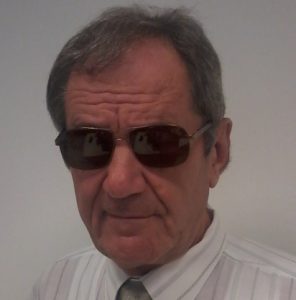Csaba Ecsedi
He lost his sight as a teenager. After completing his programming training, he worked as a telephone switchboard operator at several jobs between 1975 and 1990. Meanwhile, in 1987, he developed the Dialer Modem, which provided answering machine and automatic call-forwarding functions when connected to a landline telephone, using a machine voice. His next development was the Teletext Reader for Visually Impaired Persons, which allowed the content of a picture newspaper to be displayed on a computer (PC) screen, which could be read out in detail when connected to speech synthesizers available to the blind at the time.
Between 1990 and 2000, he worked as a system administrator in the legal department of the National Claims Settlement and Compensation Office; in the meantime, he was a freelancer for a few years.
Meanwhile, between 1993 and 1996, he worked at the Department of Telecommunications and Telematics of BME on the development of computer-supported target and assistive devices for disabled people.
Under his leadership, the TELL English-Hungarian pronunciation audio dictionary and the DLS (Dual Language Speech) bilingual speaking system were completed (with the support of the Soros Foundation and the MTA Phonetics Laboratory).
In 1998, under his leadership, you were the first in Hungary to develop the software called Hungarian Speaking Windows (MBA), which enabled the IT integration of the visually impaired to begin in a wide range of areas.
In 1999, he participated in the development of the multimedia speaking system, the MultiVox Hungarian speech synthesizer, and its improved version, ProfiVox.
Finally (within the framework of the JAWS for Windows localization project), he worked as an expert and software developer in the joint work of the BME Department of Telecommunications and Media Informatics and the Foundation for the Visually Impaired, developing a Windows-based screen reader. The result was a localized Hungarian-language screen reader with ProfiVox output, which has since been used by the visually impaired nationwide.
Since 2001, he has been participating as a preparatory teacher in IT education for the sensory impaired at the Neumann János Faculty of Informatics (NIK) of the Budapest Technical College (BMF, then Óbuda University, ÓE).
Meanwhile, under the guidance of experts, the first version of the Hungarian Speaking Mobile Phone, developed in collaboration with the Department of Telecommunications and Media Informatics of BME (TMIT), the ÓE NIK and MIT Systems (Mobile Information Technologies Development Ltd.), has been completed. This BeszT program enables the use of mobile phones by the blind and visually impaired: it reads out ("hands-free"), for example, the contact list; the list of received, unreceived and dialed numbers; sent and received messages, etc. Some special new functions also help the usability of the device.
In 2009, Kempelen was awarded the Farkas Award by the Hungarian Association of Communications and Informatics, the Hungarian Society of Optical, Acoustical Film and Theatre Technology, and the Hungarian Society of Optical, Acoustical Film and Theatre Technology for his successful work in the field of machine speech processing.
- He is the father of five adult children. (2018 announcement.)
- As a teenager, he suffered an eye injury in an accident, and his vision deteriorated completely over the years. He was completely blind when he began his professional career.
- He lived his professional career as a hobby.
Created: 2018.06.18. 13:24
Last modified: 2024.03.06. 18:40

